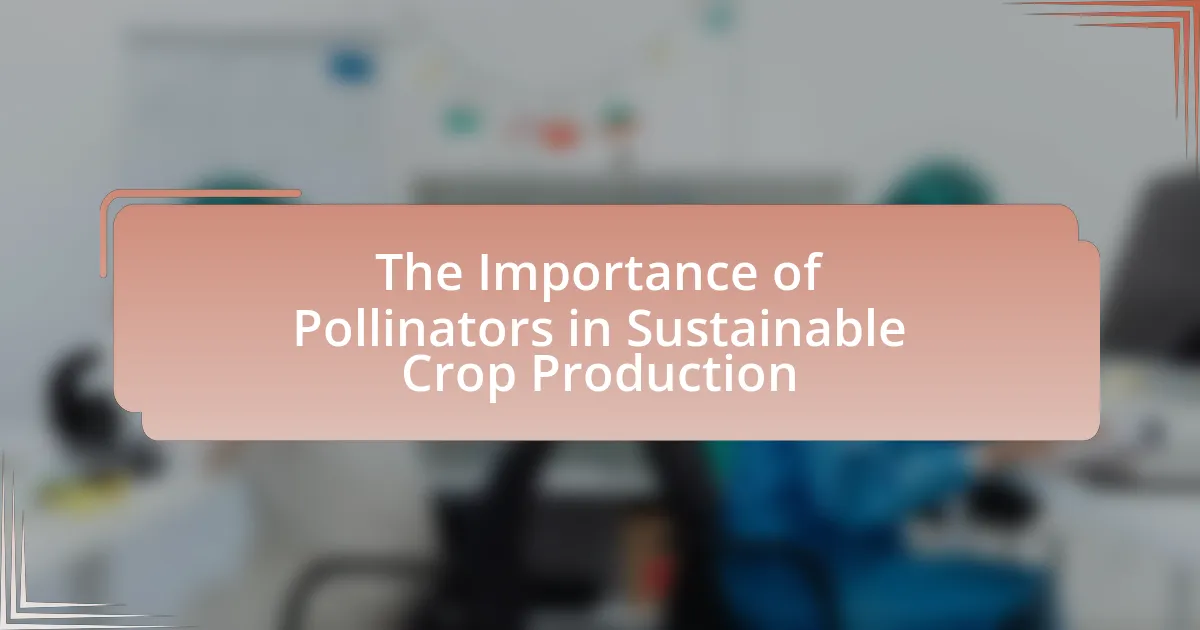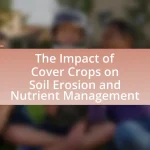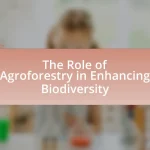Pollinators, including bees, butterflies, and birds, are essential for sustainable crop production, as approximately 75% of the world’s food crops rely on animal pollination. Their role in enhancing crop yields and improving produce quality is critical for food security and ecosystem health. The article explores how pollinators contribute to agricultural biodiversity, the challenges they face such as habitat loss and pesticide exposure, and effective strategies for farmers to promote pollinator health. It emphasizes the importance of protecting pollinator habitats and implementing sustainable farming practices to ensure the resilience of agricultural systems.

What is the role of pollinators in sustainable crop production?
Pollinators play a crucial role in sustainable crop production by facilitating the reproduction of flowering plants, which is essential for fruit and seed development. Approximately 75% of the world’s food crops depend on animal pollination, highlighting their significance in agriculture. Pollinators, such as bees, butterflies, and birds, enhance crop yields and improve the quality of produce, leading to increased food security. Research indicates that farms with diverse pollinator populations can experience up to a 50% increase in crop yields compared to those with fewer pollinators. This relationship underscores the importance of protecting pollinator habitats to ensure sustainable agricultural practices and maintain ecosystem health.
How do pollinators contribute to crop yields?
Pollinators significantly enhance crop yields by facilitating the process of pollination, which is essential for the reproduction of many flowering plants. Specifically, studies show that crops such as fruits, vegetables, and nuts rely heavily on pollinators like bees, butterflies, and birds to transfer pollen from male to female flower parts, leading to fertilization and the development of seeds and fruits. For instance, research published in the journal “Science” indicates that approximately 75% of global food crops depend on animal pollination, contributing to an estimated annual economic value of $235 to $577 billion. This reliance on pollinators underscores their critical role in increasing both the quantity and quality of agricultural produce, thereby supporting food security and sustainable farming practices.
What types of crops rely on pollinators for successful production?
Crops that rely on pollinators for successful production include fruits, vegetables, nuts, and seeds. Specifically, crops such as apples, almonds, blueberries, cucumbers, and tomatoes depend heavily on pollinators like bees and butterflies for effective fertilization and fruit set. Research indicates that approximately 75% of the world’s flowering plants and about 35% of global food crops benefit from animal pollination, highlighting the critical role of pollinators in agricultural productivity.
How does pollination affect the quality of crops?
Pollination significantly enhances the quality of crops by increasing fruit set, size, and overall yield. When pollinators, such as bees and butterflies, transfer pollen from male to female flower parts, they facilitate fertilization, which is essential for the development of seeds and fruits. Research indicates that crops like apples and blueberries exhibit improved fruit quality and higher market value when adequately pollinated, with studies showing that well-pollinated apple trees can produce fruit that is 30% larger compared to those with insufficient pollination. This correlation between effective pollination and crop quality underscores the critical role of pollinators in sustainable agriculture.
Why are pollinators essential for biodiversity in agriculture?
Pollinators are essential for biodiversity in agriculture because they facilitate the reproduction of many flowering plants, which are crucial for maintaining diverse ecosystems. Approximately 75% of the world’s food crops depend on animal pollination, highlighting their role in enhancing genetic diversity among plants. This genetic diversity is vital for ecosystem resilience, allowing agricultural systems to adapt to changing environmental conditions and pest pressures. Studies have shown that farms with higher pollinator diversity yield more productive crops, demonstrating the direct link between pollinator presence and agricultural biodiversity.
What is the relationship between pollinators and ecosystem health?
Pollinators are essential for ecosystem health as they facilitate the reproduction of flowering plants, which are crucial for maintaining biodiversity. The presence of pollinators, such as bees and butterflies, directly influences the abundance and diversity of plant species, which in turn supports various animal species and overall ecosystem stability. Research indicates that approximately 75% of the world’s flowering plants depend on animal pollinators for reproduction, highlighting their critical role in food production and habitat sustainability. This interdependence underscores the importance of protecting pollinator populations to ensure healthy ecosystems and agricultural productivity.
How do pollinators support the growth of diverse plant species?
Pollinators support the growth of diverse plant species by facilitating the process of pollination, which is essential for the reproduction of many flowering plants. This process involves the transfer of pollen from the male parts of a flower to the female parts, enabling fertilization and the production of seeds. According to the Food and Agriculture Organization, approximately 75% of the world’s food crops depend on pollinators, highlighting their critical role in maintaining biodiversity and ecosystem health. Furthermore, studies show that diverse plant species attract a variety of pollinators, which in turn enhances genetic diversity and resilience in plant populations, ultimately contributing to sustainable agricultural practices.
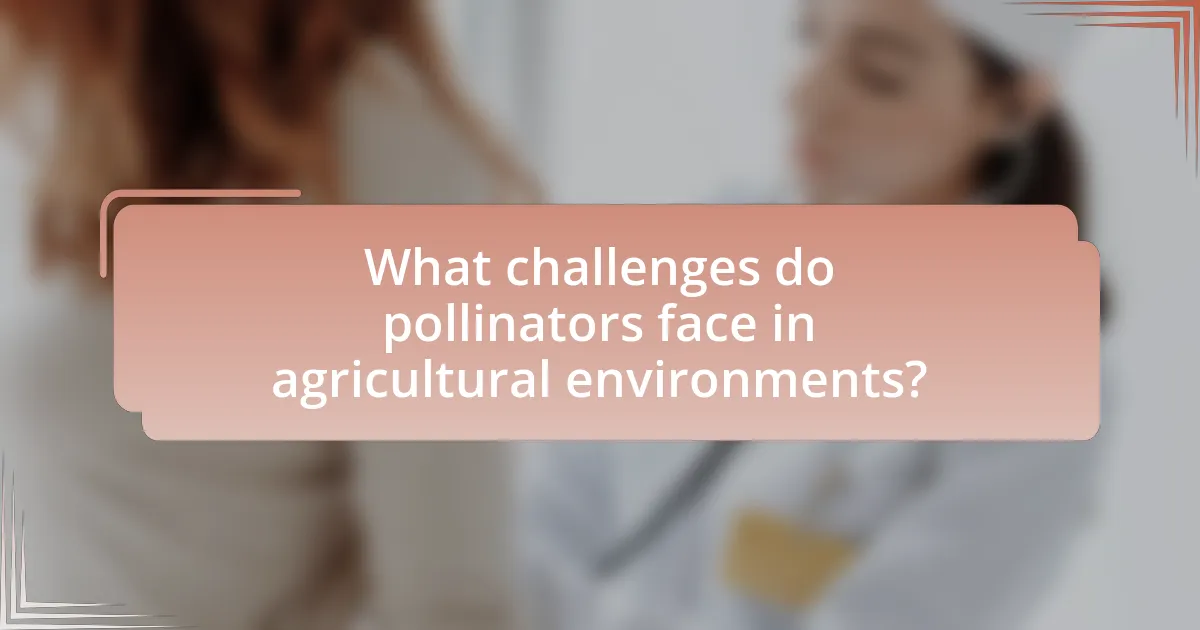
What challenges do pollinators face in agricultural environments?
Pollinators face several challenges in agricultural environments, primarily due to habitat loss, pesticide exposure, and monoculture practices. Habitat loss occurs as agricultural expansion reduces the availability of wildflower-rich areas essential for pollinator foraging. Pesticide exposure poses a significant risk, as chemicals used in farming can be toxic to pollinators, leading to population declines. Monoculture practices limit the diversity of plants available for pollinators, reducing their food sources and nesting sites. Research indicates that these factors contribute to the decline of pollinator populations, which are crucial for the pollination of many crops, thereby impacting agricultural productivity and ecosystem health.
How do pesticides impact pollinator populations?
Pesticides significantly harm pollinator populations by causing direct mortality and sublethal effects that impair their foraging and reproductive behaviors. Studies have shown that neonicotinoids, a class of pesticides, can reduce honeybee foraging efficiency by up to 50%, leading to decreased pollination success and colony health. Additionally, exposure to pesticides can disrupt the navigation abilities of bees, making it difficult for them to return to their hives, which ultimately contributes to population declines. Research published in the journal “Nature” by Goulson et al. (2015) highlights that widespread pesticide use correlates with the observed declines in bee populations across various regions, underscoring the detrimental impact of these chemicals on essential pollinators.
What are the specific effects of different pesticide types on pollinators?
Different pesticide types have varying specific effects on pollinators, significantly impacting their health and behavior. Neonicotinoids, for example, are known to cause acute toxicity in bees, leading to disorientation, impaired foraging, and increased mortality rates. Research published in the journal “Nature” by Goulson et al. (2015) indicates that exposure to neonicotinoids can reduce bee populations by up to 50%. Pyrethroids, another class of pesticides, can disrupt the nervous system of pollinators, resulting in reduced reproductive success and altered foraging patterns. A study in “Environmental Toxicology and Chemistry” by Desneux et al. (2007) highlights that pyrethroid exposure can lead to decreased pollination efficiency. Additionally, herbicides can indirectly affect pollinators by reducing the availability of flowering plants, which are essential for their nutrition. The decline in floral resources due to herbicide application has been documented in various ecological studies, emphasizing the cascading effects on pollinator populations.
How can farmers mitigate pesticide risks to pollinators?
Farmers can mitigate pesticide risks to pollinators by implementing integrated pest management (IPM) practices. IPM emphasizes the use of biological control methods, such as introducing natural predators, and cultural practices, like crop rotation, to reduce pest populations without relying solely on chemical pesticides. Research indicates that using targeted application techniques, such as spot treatments and applying pesticides during times when pollinators are less active, can significantly lower exposure risks. Additionally, selecting pesticides that are less harmful to pollinators, as indicated by their toxicity ratings, further protects these essential insects. Studies have shown that these strategies not only safeguard pollinator populations but also enhance overall crop yields and sustainability.
What role does habitat loss play in pollinator decline?
Habitat loss significantly contributes to pollinator decline by reducing the availability of food sources and nesting sites essential for their survival. As natural habitats are converted for agriculture, urban development, or other land uses, the diversity and abundance of flowering plants diminish, leading to decreased foraging opportunities for pollinators. Research indicates that habitat fragmentation can isolate pollinator populations, making it difficult for them to find mates and reducing genetic diversity, which is crucial for resilience against diseases and environmental changes. A study published in the journal “Ecology Letters” found that areas with higher habitat quality support greater pollinator diversity, underscoring the direct link between habitat availability and pollinator health.
How does urbanization affect pollinator habitats?
Urbanization negatively impacts pollinator habitats by reducing the availability of natural spaces and increasing habitat fragmentation. As cities expand, green areas such as meadows, forests, and wetlands are often replaced with buildings and roads, leading to a decline in the diversity and abundance of pollinator species. Research indicates that urban areas can support fewer pollinators due to the lack of native plants and resources they require for foraging and nesting. For instance, a study published in the journal “Ecological Applications” found that urbanization can decrease bee populations by up to 50% in some regions, highlighting the critical need for urban planning that incorporates green spaces to support pollinator health and biodiversity.
What practices can enhance pollinator habitats on farms?
Implementing diverse planting strategies, such as incorporating native flowering plants and cover crops, can significantly enhance pollinator habitats on farms. These practices provide essential food sources and nesting sites for pollinators, which are crucial for crop production. Research indicates that farms with a variety of flowering plants can increase pollinator abundance and diversity, leading to improved pollination services. For instance, a study published in the journal “Ecological Applications” found that farms with diverse plantings had up to 50% more pollinator visits compared to monoculture systems. Additionally, reducing pesticide use and creating buffer zones with wildflowers can further support pollinator health and habitat.
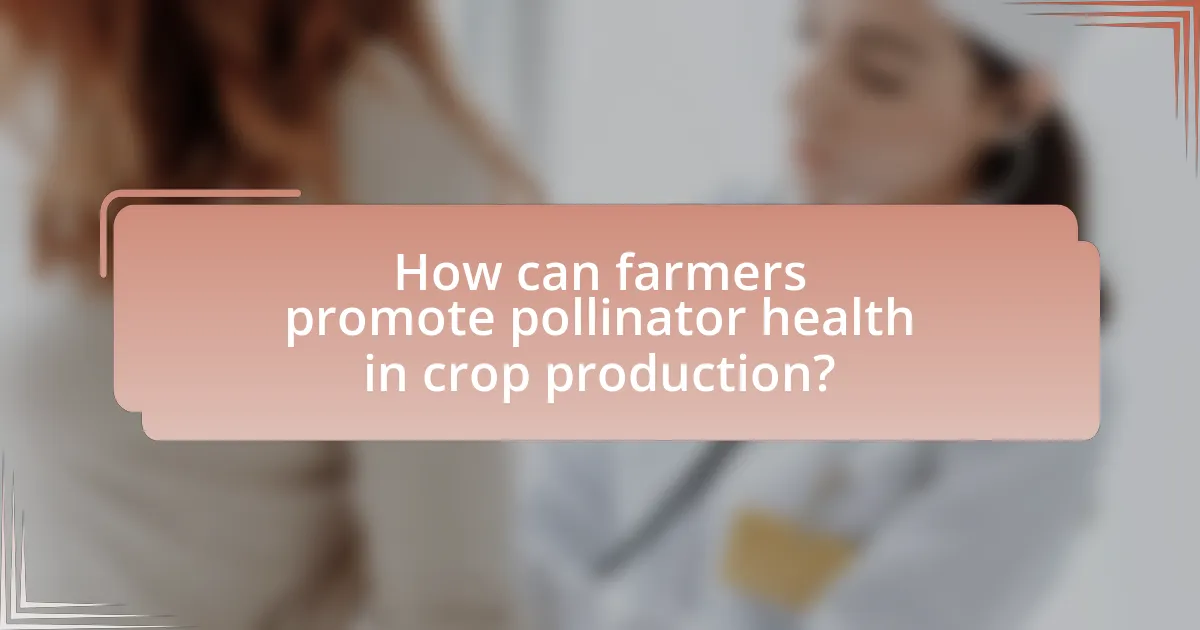
How can farmers promote pollinator health in crop production?
Farmers can promote pollinator health in crop production by implementing practices such as planting diverse flowering crops, reducing pesticide use, and creating habitats that support pollinator populations. Diverse flowering crops provide essential food sources for pollinators throughout the growing season, enhancing their health and productivity. Reducing pesticide use, particularly during flowering periods, minimizes harmful exposure to pollinators, which is crucial since studies indicate that neonicotinoids can significantly reduce bee populations. Additionally, establishing habitats like hedgerows, wildflower strips, and nesting sites can support various pollinator species, contributing to a more resilient ecosystem. Research from the University of California found that farms with diverse habitats had 50% more pollinator visits compared to monoculture farms, demonstrating the effectiveness of these practices in enhancing pollinator health.
What are effective strategies for creating pollinator-friendly environments?
Effective strategies for creating pollinator-friendly environments include planting diverse native flowering plants, providing nesting sites, and minimizing pesticide use. Diverse native plants ensure a continuous supply of nectar and pollen throughout the growing season, which is crucial for pollinator health. Research indicates that landscapes with a variety of flowering plants can support higher populations of pollinators, as they attract different species and provide essential resources. Additionally, incorporating features like bee hotels or leaving bare ground can offer nesting opportunities for solitary bees. Reducing pesticide application, particularly during flowering periods, helps protect pollinators from harmful chemicals, thereby promoting their survival and effectiveness in crop production.
How can cover crops benefit pollinators?
Cover crops can benefit pollinators by providing essential food sources and habitat. These crops, such as clover and buckwheat, produce flowers that attract various pollinators, including bees and butterflies. Research indicates that fields with diverse cover crops can increase pollinator abundance and diversity, enhancing ecosystem services. For instance, a study published in the journal “Agriculture, Ecosystems & Environment” found that cover crops significantly improved pollinator visitation rates, which are crucial for the pollination of subsequent cash crops. This relationship underscores the role of cover crops in supporting pollinator health and, consequently, sustainable crop production.
What role do wildflower strips play in supporting pollinators?
Wildflower strips play a crucial role in supporting pollinators by providing essential habitats and food sources. These strips enhance biodiversity by offering a variety of flowering plants that attract and sustain pollinator populations, such as bees and butterflies. Research indicates that wildflower strips can increase pollinator abundance and diversity, leading to improved pollination services for nearby crops. For instance, a study published in the journal “Agriculture, Ecosystems & Environment” found that fields adjacent to wildflower strips had up to 50% more pollinator visits compared to those without. This increase in pollinator activity directly correlates with higher crop yields, demonstrating the significant impact of wildflower strips on sustainable agricultural practices.
What best practices should farmers adopt to protect pollinators?
Farmers should adopt integrated pest management (IPM) practices to protect pollinators. IPM minimizes the use of harmful pesticides by incorporating biological control methods, crop rotation, and habitat enhancement, which collectively reduce pesticide exposure to pollinators. Research indicates that using IPM can decrease pesticide use by up to 50%, thereby significantly lowering the risk to pollinator populations. Additionally, farmers should plant diverse flowering crops and maintain hedgerows or wildflower strips to provide food and habitat for pollinators throughout the growing season. Studies show that farms with greater floral diversity support higher pollinator abundance and diversity, which is crucial for effective crop pollination.
How can integrated pest management support pollinator populations?
Integrated pest management (IPM) can support pollinator populations by minimizing the use of harmful pesticides and promoting biodiversity. IPM strategies often include monitoring pest populations, using biological control methods, and applying targeted treatments, which reduce the overall chemical exposure to non-target species, including pollinators. Research indicates that farms employing IPM practices show higher abundance and diversity of pollinators compared to conventional farming methods, as these practices create a more balanced ecosystem. For instance, a study published in the journal “Agriculture, Ecosystems & Environment” found that IPM can lead to a 30% increase in pollinator visitation rates, demonstrating its effectiveness in fostering healthier pollinator communities.
What are the benefits of organic farming for pollinators?
Organic farming benefits pollinators by promoting biodiversity and reducing chemical exposure. This farming method enhances habitat quality through diverse crop rotations and the inclusion of flowering plants, which provide essential food sources for pollinators. Additionally, organic practices limit the use of synthetic pesticides and fertilizers, which can be harmful to pollinator health. Research indicates that organic farms support higher populations of bees and other pollinators compared to conventional farms, as evidenced by a study published in the journal “Agriculture, Ecosystems & Environment,” which found that organic farms had 50% more bee species than non-organic farms. This increase in pollinator diversity is crucial for sustainable crop production, as it leads to improved pollination services and higher yields.
What resources are available for farmers to learn about pollinator conservation?
Farmers can access various resources to learn about pollinator conservation, including government programs, educational organizations, and online platforms. The U.S. Department of Agriculture (USDA) provides resources such as the Pollinator Partnership, which offers guidelines and best practices for creating pollinator-friendly habitats. Additionally, organizations like the Xerces Society for Invertebrate Conservation provide research-based information and technical assistance to farmers. Online platforms, including webinars and courses from universities, also serve as valuable educational tools. These resources are supported by research indicating that effective pollinator conservation practices can enhance crop yields and biodiversity, thereby contributing to sustainable agriculture.
Where can farmers find educational materials on pollinator-friendly practices?
Farmers can find educational materials on pollinator-friendly practices through various agricultural extension services, universities, and non-profit organizations dedicated to sustainable agriculture. For instance, the Xerces Society for Invertebrate Conservation offers resources specifically focused on pollinator conservation, including guides and research articles. Additionally, the USDA’s Natural Resources Conservation Service provides information on best management practices for pollinators, which can be accessed through their website. These sources are credible and widely recognized in the agricultural community for promoting sustainable practices that support pollinator health.
What organizations support pollinator health initiatives in agriculture?
Organizations that support pollinator health initiatives in agriculture include the Pollinator Partnership, the Xerces Society for Invertebrate Conservation, and the U.S. Department of Agriculture (USDA). The Pollinator Partnership focuses on habitat restoration and education to enhance pollinator populations, while the Xerces Society conducts research and advocates for policies that protect pollinators. The USDA implements programs that promote sustainable agricultural practices benefiting pollinators, such as the Conservation Reserve Program, which incentivizes farmers to create pollinator-friendly habitats. These organizations collectively contribute to the health and sustainability of pollinators, which are crucial for crop production.
